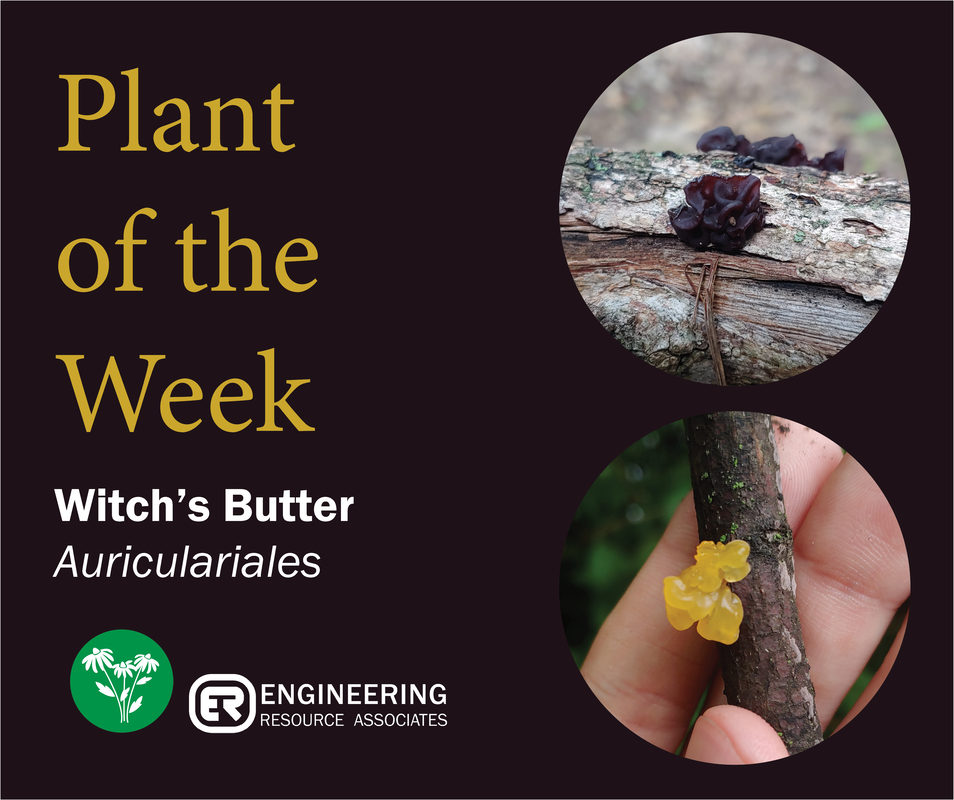This week we will wrap up the plant of the week feature with a Halloween special edition organism of the week!
This week’s organism of the week is Witch’s Butter! Witch’s Butter refers to a wide variety of jelly fungus in the family Auriculariales known to inhabit many parts of the world.
Yellow Witch’s Butter (Tremella mesenterica) is appropriately named due to the color and perceived texture of the fungus as well as the now-dismissed notion that it was used by witches to hex people in the area it was first described, Sweden. It is commonly found on maples, alders, pine, and poplar in wet to mesic wooded areas and can also be found on dead (but still attached) branches and freshly fallen limbs. Fruiting bodies appear as gelatinous amorphous blobs with a glossy finish and a semi-solid consistency. They are noted by some groups as being edible but are generally known to have very little flavor and an unpleasant texture. There are also a few species of fungus that resemble T. mesenterica with minor physical differences such as a matte finish or differing size of folds or creases.
Black Witch’s Butter (Exidia glandulosa) is much the same despite being placed into a different genus. It is also found on recently dead and decaying wood, but tends to associate primarily with oaks, hazel, or beech. E. glandulosa is known to primarily consume a layer of woody plants called the cambium. The cambium is the only living and growing part of woody plants. It is a very thin layer of cells located between the bark and center wood of the plant. As a result, woody plants colonized by this organism will lose bark and help to improve the decomposition process.
To recap, both species are known to have a metropolitan distribution, meaning they are found widely throughout the globe. They are known to colonize recently dead branches and limbs and can be found throughout the year following a period of rain or high humidity. Should you ever come across the mysterious looking Witch’s Butter on your travels, thank it for its contribution in helping keep woody debris to a minimum in our forests, and watch your back for whoever might be seeking ingredients for spells!
This week’s organism of the week is Witch’s Butter! Witch’s Butter refers to a wide variety of jelly fungus in the family Auriculariales known to inhabit many parts of the world.
Yellow Witch’s Butter (Tremella mesenterica) is appropriately named due to the color and perceived texture of the fungus as well as the now-dismissed notion that it was used by witches to hex people in the area it was first described, Sweden. It is commonly found on maples, alders, pine, and poplar in wet to mesic wooded areas and can also be found on dead (but still attached) branches and freshly fallen limbs. Fruiting bodies appear as gelatinous amorphous blobs with a glossy finish and a semi-solid consistency. They are noted by some groups as being edible but are generally known to have very little flavor and an unpleasant texture. There are also a few species of fungus that resemble T. mesenterica with minor physical differences such as a matte finish or differing size of folds or creases.
Black Witch’s Butter (Exidia glandulosa) is much the same despite being placed into a different genus. It is also found on recently dead and decaying wood, but tends to associate primarily with oaks, hazel, or beech. E. glandulosa is known to primarily consume a layer of woody plants called the cambium. The cambium is the only living and growing part of woody plants. It is a very thin layer of cells located between the bark and center wood of the plant. As a result, woody plants colonized by this organism will lose bark and help to improve the decomposition process.
To recap, both species are known to have a metropolitan distribution, meaning they are found widely throughout the globe. They are known to colonize recently dead branches and limbs and can be found throughout the year following a period of rain or high humidity. Should you ever come across the mysterious looking Witch’s Butter on your travels, thank it for its contribution in helping keep woody debris to a minimum in our forests, and watch your back for whoever might be seeking ingredients for spells!

